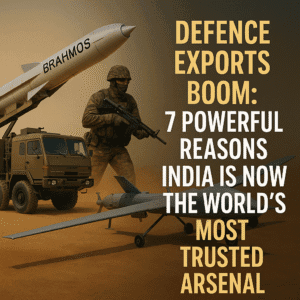Defence Exports Boom: 7 Powerful Reasons India Is Now the World’s Most Trusted Arsenal
India has dramatically transformed its defence sector from heavy import dependence to a globally trusted exporter, achieving 65% domestic military equipment production. Strategic policy reforms unlocked private sector potential and prioritized indigenous manufacturing, creating a vast industrial ecosystem. Crucially, India’s platforms earned war-tested credibility through proven battlefield performance, boosting global confidence. Exports surged 34-fold in a decade, reaching $2.8 billion (FY25) to 80 countries, including sophisticated hardware like BrahMos missiles and advanced radars. NATO’s increased spending targets create massive demand, but Europe’s limited capacity and aversion to Chinese tech open a strategic window.
India’s compelling advantages – cost-effective, scalable manufacturing combined with combat-proven tech and geopolitical neutrality – position it as a vital alternative supplier. While challenges like tech gaps and bureaucracy remain, ongoing reforms and integration into Western supply chains signal a fundamental shift: India is now a serious player in the global defence industrial base, valued for both capability and reliability.

Defence Exports Boom: 7 Powerful Reasons India Is Now the World’s Most Trusted Arsenal
For decades, India’s military might leaned heavily on foreign suppliers – a strategic vulnerability and a drain on resources. Today, a profound shift echoes through global defence corridors. India isn’t just building its own arsenal; it’s becoming a trusted exporter, with defence exports surging 34-fold over the past decade to a landmark $2.8 billion in FY25. This remarkable journey from dependency to global contender reveals a potent mix of strategic vision, industrial grit, and battlefield validation.
The Engine of Transformation: Policy and Pragmatism
Recognizing the perils of import reliance, India embarked on a deliberate path to self-reliance (“Aatmanirbharta”). Key catalysts ignited this change:
- Ambitious Policy Frameworks: The Defence Production Policy 2018 set a bold vision: elevate India into the world’s top five defence producers. The Defence Acquisition Procedure 2020 acted as an enabler, streamlining procurement and mandating a strong preference for indigenous designs and manufacturing.
- Unlocking Industrial Capacity: Moving beyond solely state-run units (DPSUs), reforms actively integrated over 430 licensed private firms and approximately 16,000 MSMEs into the defence ecosystem. This unleashed innovation, competition, and crucial supply chain depth.
- The Cost-Quality Proposition: India’s significant cost advantages in skilled labour and manufacturing, coupled with rapidly improving infrastructure, became impossible for global players to ignore. European defence giants increasingly see India not just as a market, but as a vital, cost-effective manufacturing partner.
Battlefield Cred: The Ultimate Endorsement
Policy and cost alone don’t win global defence contracts; proven performance does. A pivotal factor in India’s rising credibility has been the combat validation of its indigenous platforms. Whether facing rugged terrains or sophisticated threats, Indian-designed and manufactured systems have demonstrated reliability and effectiveness in real-world operations. This “war-tested” status is a powerful differentiator in a market where failure is not an option. The Army’s rigorous large-scale trials of next-gen drones, electronic warfare suites, and air defence systems further signal a commitment to cutting-edge, proven technology.
Export Surge and Global Footprint:
The results are undeniable:
- Domestic production now fulfils approximately 65% of the Indian military’s equipment needs.
- Exports have rocketed to $2.8 billion (FY25), reaching around 80 countries, including sophisticated markets like Brazil, Vietnam, and even the US.
- Key exports span the spectrum: advanced artillery guns, precision rifles, formidable supersonic cruise missiles (like BrahMos), sophisticated radars, electronic warfare systems, and versatile UAVs.
- Giants like BEL, HAL, and BDL, alongside dynamic private players like L&T and Tata Advanced Systems, are spearheading this export drive with proven capabilities.
A NATO Windfall and India’s Strategic Opening:
NATO’s recent commitment to raise defence spending to 5% of GDP by 2035 creates an unprecedented global demand surge. Europe faces a critical challenge: its own atrophied manufacturing base cannot rapidly meet the need to replenish and modernize vast arsenals. While the US remains the primary supplier, geopolitical realities make turning to China untenable.
This is where India shines: It offers a unique combination:
- Cost-Effectiveness: Competitive manufacturing without compromising on quality.
- Battle-Proven Tech: Systems validated under operational stress.
- Scalability: A vast industrial ecosystem capable of ramping up production.
- Geopolitical Neutrality: A trusted partner without adversarial baggage.
- Rapid Industrial Maturity: Demonstrated ability to absorb technology and deliver complex systems.
Deals like co-producing rocket launchers with France and artillery cannons with the US underscore this growing acceptance and integration into Western supply chains.
Navigating the Challenges Ahead:
The path forward isn’t without hurdles. Bridging technological gaps in cutting-edge systems, streamlining supply chains, reducing bureaucratic inertia, and navigating volatile regional tensions require sustained focus. Global competition remains fierce.
Yet, the trajectory is clear. Continued reforms, increased investment in R&D (especially in AI and cyber defence), and a deepening culture of innovation position India uniquely. The transformation from a vulnerable importer to a confident exporter and manufacturing hub is more than an economic success story; it’s a fundamental shift in India’s strategic autonomy and its role in the global security architecture.
As Europe and others seek reliable, diversified suppliers for the volatile decades ahead, India’s defence industry, forged through policy, pragmatism, and battlefield fire, stands ready as a compelling partner. The world’s defence factories, indeed, now look towards India.
You must be logged in to post a comment.